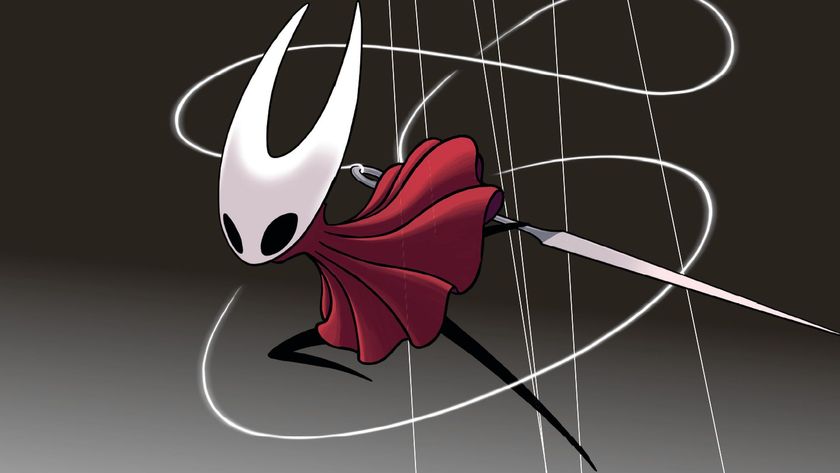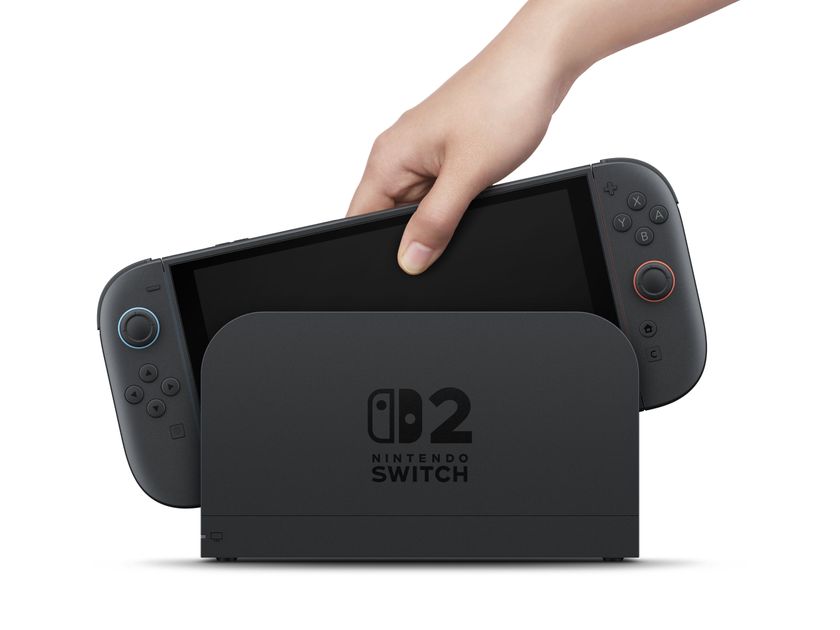Remarkably different games that were made with the same game engine
Separated at birth

As a naive youth, I thought game development involved pixies and sprites wishing games into existence. Eventually, I realized that real, live people spend thousands of hours just to make a single game. Once I got over my sad realization that magic isnt real, I began to wrap my head around the tools and processes of game development, including game engines game engines--tools that serve as the foundation for video games. I was intrigued by how surprisingly versatile they can be.
Engines like Frostbite, Unreal, and CryEngine are found in so many major titles, but a true sign of great design tools is adaptability. A great engine needs to be able to used for a shooter, sports game, or child-friendly platformer if the need arises. This feature celebrates all the strangest instances of engine versatility; tech that could handle fountains of blood and Disney characters in equal measure. These duos show that games are better defined by the creative people that make them, not the technology that powers them.
Crysis 3 and Sonic Boom run on CryEngine 3

Crytek loves to show off its continually-improving technology. Games like Far Cry, Crysis, and Ryse had their issues, but were universally lauded for their fancy visuals, all thanks to the Cryteks proprietary CryEngine. Clearly, the developers are fans of the word cry, and theyre also experts at lifelike visuals, gore, and first-person shooters, all of which CryEngine can support with ease. Odd, then, that Sega would choose the same tech for its upcoming update to Sonic the Hedgehog.
Sonic Boom is a Nintendo exclusive planned to reintroduce the blue hedgehog to a whole new generation of kids, and Sonics US-based dev team felt CryEngine 3 was the perfect fit. The same tools that saw urban jungle warfare of Crysis 2 will support Tails and Knuckles trashing robots, and Segas explanation for the move is sensible. You associate CryEngine with lush, tropical, beachy things. These are also things with which Sonic is associated, so they work together. Understandable, but does this mean Sonic will be getting a Nanosuit at some point?
PES Soccer 2014 and Metal Gear Solid 5 run on... FOX Engine

Soccer is a sport loved all over the world (so long as you dont count the US). But despite American indifference to what some call football, sports games like Pro Evolution Soccer are big sellers. Perhaps in a move to to stay ahead of competition like FIFA, last years iteration of PES got a technological upgrade via its unlikely Konami stablemate, Metal Gear Solid.
Metal Gear creator Hideo Kojima envisioned the FOX Engine to be Konamis go-to tech for current and next-gen games, with Metal Gear Solid 5 showcasing his new development tools. But before the all-too-brief prologue of Ground Zeroes was released, last Septembers PES used FOX to make realistic soccer hooligans. Even if the on-field battles couldnt compare to blasting tanks from a helicopter, PES did showcase Foxs versatile cloth physics and character animations. Could the same engine work as well for other Konami mainstays, like Silent Hill or Castlevania?
Metroid Prime and Donkey Kong Country Returns run on... the Prime engine
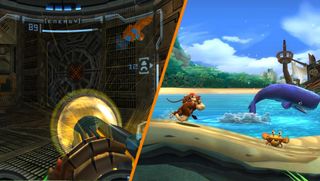
Nintendo isnt the biggest fan of explaining its tech to outsiders, perhaps because it has no intention of sharing development secrets with the competition. Nintendos Austin, TX-based Retro Studios recently let loose a bit more behind-the-scenes info than fans are used to, revealing that Donkey Kong Country Returns and Metroid Prime were built with the same tools. Yes, the same engine that made Samus Zero Suit was also behind Donkeys furry butt.
Sign up to the 12DOVE Newsletter
Weekly digests, tales from the communities you love, and more
Its a logical conclusion that Retro would reuse whatever tech it could when rebooting DKC, but the 2D jungles of Donkey Kong Island are pretty far removed from searching abandoned space stations in first person. Its a credit to the team that two very different Nintendo mascots could spring from the same dev tools. It makes you wonder what type of unexpected Nintendo titles Retro could make with Donkey Kong Country: Tropical Freezes more advanced engine.
Gone Home and Leisure Suit Larry: Reloaded run on Unity

Unity has become one of the most heavily used engines among the indie game community. The last few years have seen the relatively affordable, cross-platform toolset picked up by many smaller teams in the burgeoning independent scene. Its been used on so many genres and art styles that several interesting parallels could be drawn, but 2013 titles Gone Home and Leisure Suit Larry: Reloaded give the best sampling of the high and low art possible with Unity.
Leisure Suit Larry is one of many successful Kickstarter games that adapted Unity to recreate the musty adventure game as a slightly spiffier sex romp for today. Meanwhile, Gone Home wielded Unity to create a family drama played out in first person, as a young woman explores her familys home to discover the secret to her sisters strife. One a loving look back at PC gamings ribald past, the other an expression of the storytelling potential yet to be exploited by gameplay, both made possible with Unity.
Call of Juarez: Bound in Blood and Naild run on Chrome Engine 4

Techlands Chrome Engine has metamorphosized over the companys lifetime, and is currently in its sixth iteration. The Polish developers have proven adept at using Chrome to make gritty FPSs like Dead Island and the upcoming Dying Light. And before Techlands zombie phase, Chrome Engine 4 built the western world of Call of Juarez: Bound in Blood, a prequel full of cursing bandits and bloody gunfights. Then, just one year later, that same engine was running online dirt bike races.
Naild and its odd punctuation are basically forgotten, but its crazy to think that off road races set to the music of Slipknot and Rise Against could work well when Call of Juarez exists in a world that predates the creation of ATVs and Slipknot. The move makes a little more sense with the knowledge of Techlands lengthy background making racing games with on earlier iterations of Chrome. Makes you wonder what Techland could do with a racing game using the same engine as Dying Light--I suppose youd probably run over your share of the undead.
Epic Mickey and Splatterhouse run on... Gamebryo

One release features the Disney corporate mascot making his big return to gaming in a title developed by the creator of Deus Ex. The other is Namcos insanely bloody reboot of a horror classic from the TurboGrafx. Despite how little Mickey and Splatterhouses Rick have in common, both titles were made using Gamebryo, an engine thats as versatile as any from the last five years.
Gamebryo is also at the core of eccentric titles like Catherine and El Shaddai, but the differences between Epic Mickey and Splatterhouse are what really shows off the range of the tools. Then again, the devs did have similar goals with both games. Much of Epic Mickey had the mouse covering platforming levels in magic paint. Splatterhouse did the same thing, only it replaced paint with blood and a brush with intestines.
FantaVision and God of War run on... Kinetica
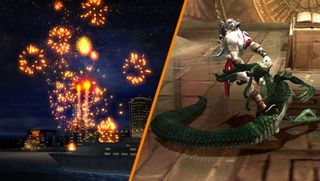
The PlayStation 2 may have had a huge library of releases, but it was also known as a somewhat difficult machine to develop for, especially early on. Sonys Santa Monica Studio was one of the earliest teams to build a quality engine for the hardware, making Kinetica, which went on to power FantaVision, a PS2 launch title that was more demo that not. Less than four years later, those tools would certainly grow, going on to power one of the systems biggest blockbusters, God of War.
Given its position as an internal studio, its not too shocking that Santa Monica made such an enduring engine. Kinetica also powered the gorgeous Getaway games, as well as SOCOM, Jak, and many other Sony exclusives, with Kratos visceral debut perhaps being the crowning achievement of the engine. All this from an inauspicious start simulating fireworks during the PlayStation 2s disappointing launch.
Earth Defense Force: Insect Armageddon and Dora the Explorer: Journey to the Purple Planet run on... Vicious Engine
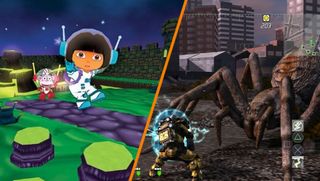
Earth Defense Force is a series that isnt treated with much reverence. Fans embrace it because blowing up giant bugs with robots is idiotic fun, and they dont expect much more from. Parents have the same low expectations when buying super simple games for their five-year-olds, and thats about the only thing a Dora the Explorer game has in common with EDF--aside from the Vicious Engine, that is.
Insect Armageddon was the American-developed sequel to a Japanese franchise, and its just the type of insane bug hunt youd expect. And despite EDFs B-game nature, the series likely felt like a step up for the developer, who had previously used its proprietary engine on numerous child-friendly games. Titles based on Curious George and Ben 10 were just a prelude to Dora the Explorer, a simple series known to enthrall little kids and adults under the influence of certain controlled substances. The developer hasnt released a game in a couple years, but if the team showed off the engine by displaying Dora and EDF side-by-side, Id bet theyd score a few new clients.
Rev up your engines

Hopefully youve learned a thing or two about game design today. In fact, I bet you learned so much that you could craft your own title in no time. Once youre finished, send us a link to your game in the comments below. Or, if youre too lazy to make a game from scratch, feel free to just discuss this feature in the comments!
And if you're looking for more info on making games, check out the the first games of legendary developers and the six things you may not know about game development (by a former game developer).
Henry Gilbert is a former 12DOVE Editor, having spent seven years at the site helping to navigate our readers through the PS3 and Xbox 360 generation. Henry is now following another passion of his besides video games, working as the producer and podcast cohost of the popular Talking Simpsons and What a Cartoon podcasts.

